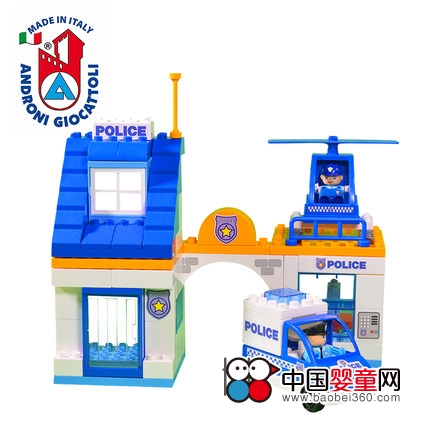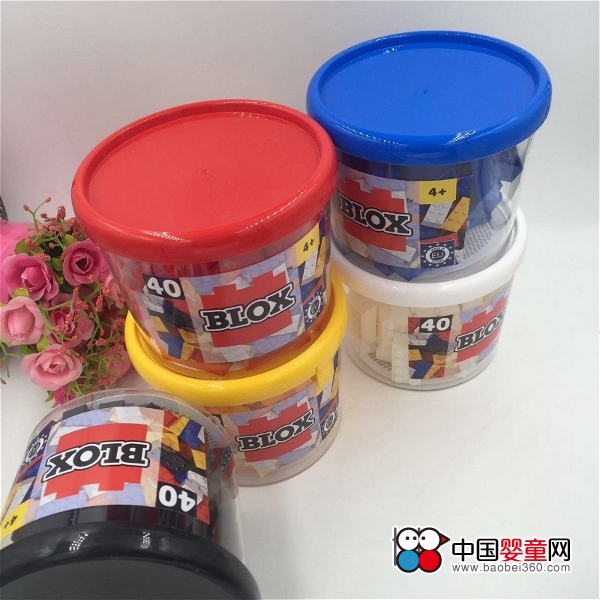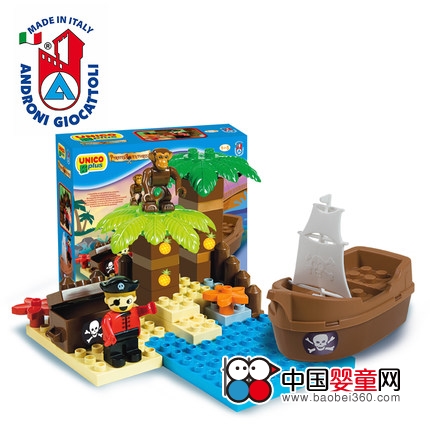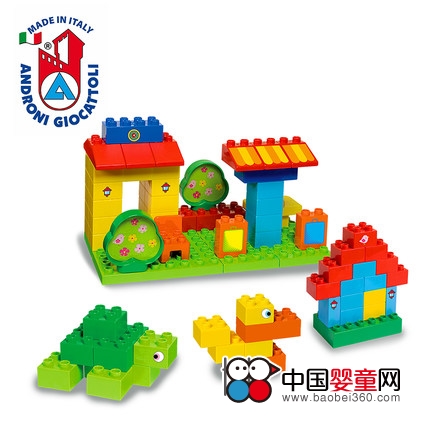Andrew Ni: What parents must know about building blocks
Choose the right building block
The child itself has the open genetics of humanity - the gene of art. Building blocks allow the child's innate potential to be fully utilized. However, whether the building blocks can play such a function depends on whether the building blocks and gameplay you choose are suitable for children.
0 to 1 year old: colorful cloth blocks
Children before the age of 1 have not yet formed a real sense of space. The standard hexahedron, bricks with certain texture and mechanical mechanics are not very meaningful to them, so it is best to choose interesting blocks. Such as cloth blocks, it is soft, bright colors, and animal or fruit patterns, so that children can perceive color, recognize objects, develop touch, etc., and don't worry about hard blocks hurting children. Of course, dolls, clothed animal toys, books, etc. can also play these roles if no such toys are prepared.
Remember: Little babies like to put everything they have in their mouths, so whether it's wooden blocks or bricks, it's safe and non-toxic.
1 to 2 years old: lightweight building blocks
The space consciousness of children over one year old is forming and will start to be high. Even if there are no bricks, they like to put everything together, and then watch it fall happily. If you paint on a building block, there are decorations such as a puppy, a kitten or a doll, and the child will prefer to play.
Because the child's body control and hand-eye coordination ability is not very good during this period, it is necessary to choose lightweight building blocks to prevent the child from being injured when the building blocks collapse. The blocks should not be too big for the child to grasp.
2 to 3 years old: standard size building blocks
The concept of space, language, thinking and imagination of children over 2 years old have been developed. The movement of hands and the coordination of hand and eye are enhanced, and things that are slightly more complicated can be done. At this time, you can choose the standard building blocks for him. For example, the two semi-circles are just in a perfect circle. The length of the two short blocks is exactly equal to a long building block. This building block can give children more space to create and express.
At the same time, in order to increase children's interest in building blocks, you can buy less difficult blocks. For example, draw a wave on a triangular building block, fixedly as a roof, square blocks of windows and doors, children can easily identify, know which building blocks can be placed. If the child knows how to take it, he can go without a teacher, which will increase the child's sense of accomplishment. If you add some auxiliary materials, such as dolls and kitchen toys, you can play a symbolic game.

Method of providing building blocks
The seemingly simple building blocks actually contain a lot of functions. Because it is simple, it can change the infinite gameplay, which also leaves more room for imagination and creation. Let’s take a look and see what benefits can the building blocks bring to the children?
1. Exercise hand-eye coordination. When stacking wood, children need to use their hands dexterously, thus promoting the development of fine movements. Stacking scattered blocks out of complex objects can also improve hand-eye coordination.
2. Cultivate observation. Objects such as houses that children bring out are actually common in life. They must first learn to observe, and then in the process of playing, the things observed in daily life are expressed in blocks. Observation is cultivated unconsciously.
3. Develop communication skills. It is best to let the children build blocks with other children, which is more fun than playing alone. Moreover, children build blocks together and inspire each other, so they will play more seriously and benefit from the ability to develop children and get along with others.
4. Make your child more confident. The process of building blocks can be completely controlled by the children themselves, which will bring satisfaction and self-confidence to the children.
5. During the process of playing with blocks, children can learn a lot of mathematics and cultivate space, imagination, creativity and language skills.

Understanding geometry
The shape, size, and length of the blocks vary. Children can distinguish between geometric shapes such as cuboids, cubes, cylinders, and so on. Standard building blocks have a certain size and proportion. During the process of playing, children can perceive the different shapes, proportions, sizes, thicknesses, heights, lengths, etc. of the blocks.
1. Jianbao Tower
Prepare a few square and round blocks for your child and teach him a high code. Then place a triangle or cone of volume wood at the highest position as the roof.
There are at least 2 blocks to play with, from 2 to 3, and 4, and the number is increasing. Children will gradually understand that the more building blocks, the more complex objects can be built; the higher the setting, the easier it will collapse. In the process of playing, the child knows that the big blocks are placed below, and the small blocks are placed on it, so that the pagoda is not easy to fall down. Unconsciously, the child understands the concepts of how much, size, weight, height, and height.
2. Find graphics
Let the children know the building blocks of various geometric figures, such as circles, semicircles, triangles, rectangles, etc., and then you say a shape of the building blocks, so that he can accurately find out from a pile of wood. You can also play against your child, see who? Find it quickly and accurately. This allows the child to understand the geometry and is also good for developing children's observation and memory.
3. Double
Two identical rectangular blocks are grouped into a square, two triangles are paired into a square, two semicircular pairs are formed into a circle, and so on. This game can help children understand the relationship between different graphics and understand the concept of part and whole. Mom and Dad's micro-signal: bamaying and in the process of playing, the child needs to use the eyes to observe whether the different shapes of the building blocks can be matched, which is very beneficial to the cultivation of observation power.
4. For numbers
Prepare a set of blocks marked with numbers. You first code several pieces according to the numbers on the building blocks, from small to large, and then let the children put the corresponding digital blocks on the next number. If you put the wrong building blocks, or if you knocked down the original building blocks in the process of putting them down, you will lose. This game helps children understand the relationship between numbers and makes children's concept of numbers clearer.
5. Who has more bricks?
First, the mother and the child each have equal numbers of blocks, and then play the game of "stone scissors". Every time you play, the winning party gets a piece of brick from the other side. After playing 3 times, count the number of blocks that each side owns. This game allows children to understand the difference between more and less, and has an initial understanding of addition and subtraction.

Build space concept
Children like to build beautiful buildings with bricks. At the time of construction, he had to imagine the position of each piece of brick in the building, and then placed each piece of wood in the most appropriate place. This is the basis of the sense of space.
1. The building blocks are down.
You code the blocks together, and when the code reaches a certain height, let the child push it down by hand. The child usually laughs happily when he sees the fall of the building blocks. Although this is just a very simple "destruction" game, it is an important activity for children to improve their spatial awareness.
2. Curved path
Teach your child to arrange long strips at regular intervals to connect them into a winding path. Give the child a toy car, he can play along this "small road", and ask for the best not to touch the blocks. This can exercise the child's ability to visually measure the spatial distance, and cultivate a sense of three-dimensionality and hand-eye coordination.
3. Bowling
First arrange the cylindrical wood of different colors into an inverted triangle, then let the child leave a distance, take a ball to the building block, and knock the building block down. As the child's ability increases, you can gradually increase the distance. This game requires the child to have a sense of direction, which is also helpful for improving attention and exercising coordination.
4. Dominoes
Arrange the blocks in the form of dominoes, then knock down the blocks that are placed at the front or the rear to see the interesting sight of the blocks falling down in order. During the placement of the blocks, the child needs to accurately determine the spatial distance, and requires accurate and highly focused hand movements.

  Andrewy toys, colorful, safe and healthy, puzzles and brains, buy toys can buy the Andrews building blocks to insert toys. Andrewni has always insisted on 100% manufacturing in Italy. From design to raw material procurement to production and packaging, all of them are completed by local professional teams, and the best products are presented to Chinese consumers. This will definitely step into the Chinese market. It is an important milestone for andronigiocattoli and even the Italian toy manufacturing industry. Andrewny Building Blocks allows children to exercise their hands and brains while having fun, and to let their children have a happy and warm childhood!
A cabinet is a case or cupboard with shelves and/or drawers for storing or displaying items. Some cabinets are stand alone while others are built in to a wall or are attached to it like a medicine cabinet. Cabinets are typically made of wood (solid or with veneers or artificial surfaces), coated steel (common for medicine cabinets), or synthetic materials. Commercial grade cabinets usually have a melamine-particleboard substrate and are covered in a high pressure decorative laminate, commonly referred to as Wilsonart or Formica.
Cabinets sometimes have one or more doors on the front, which are mounted with door hardware, and occasionally a lock. Cabinets may have one or more doors, drawers, and/or shelves. Short cabinets often have a finished surface on top that can be used for display, or as a working surface, such as the countertops found in kitchens.
A cabinet intended to be used in a bedroom and with several drawers typically placed one above another in one or more columns intended for clothing and small articles is called a dresser or a Chest Of Drawers. A small bedside cabinet is more frequently called a Nightstand or night table. A tall cabinet intended for clothing storage including hanging of clothes is called a wardrobe or an armoire, or (in some countries) a closet if built-in.
Living Room Drawer Cabinet,Living Room Storage Chest,Living Room Display Cabinet,Living Room Storage Cabinet,Living Room Cabinet Furniture,Living Room Dresser Cabinet,STORAGE CABINET,Wood Cabinet
Jinan Tri-Tiger Technology Development Co., Ltd , https://www.tritigerwooden.com